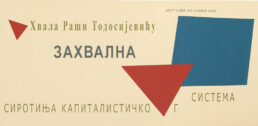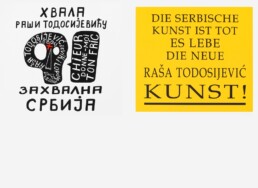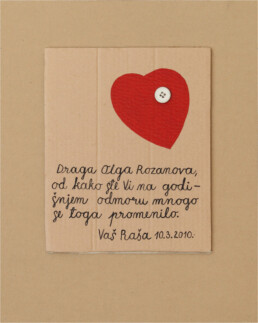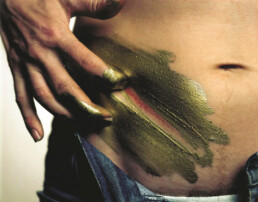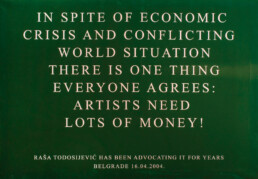DRAGOLjUB RAŠA TODOSIJEVIĆ (1945)
Thank You Raša Todosijević, the Grateful Poor of the Capitalist System
lithograph
70 cm x 101 cm
2005
Serbian Art Is Dead, Long Live the Art of Rasa Todosijević
screen print
83 cm x 70 cm, diptych
2006
Dear Olga Rozanova
acrylic on cardboard
30 cm x 25 cm
2010
Art, Sex and History
digital print
85 cm x 67 cm, triptych
2012
Despite the Economic Crisis…
print on canvas
97 cm x 140 cm
2004
Thank You Raša Todosijević, the Grateful Poor of the Capitalist System
lithograph
70 cm x 101 cm
2005
Serbian Art Is Dead, Long Live the Art of Rasa Todosijević
screen print
83 cm x 70 cm, diptych
2006
Dear Olga Rozanova
acrylic on cardboard
30 cm x 25 cm
2010
© Cultural Centre of Belgrade, the October Salon Collection and the artist
Gift Contract: III-5-293/29.9.2014.
Inventory No. 1362, 1363, 1364
Photo: Milan Kralj
Art, Sex and History
digital print
85 cm x 67 cm, triptych
2012
© Cultural Centre of Belgrade, the October Salon Collection and the artist
Purchase Contract: III-5-481/1/15.12.2014.
Inventory No. 060
Photo: Milan Kralj
Despite the Economic Crisis…
print on canvas
97 cm x 140 cm
2004
© Cultural Centre of Belgrade, the October Salon Collection and the artist
Gift Contract: III-5-11/15.1.2016.
Inventory No. 077
Photo: Milan Kralj
What singles out Raša Todosijević from other participants of the informal Belgrade group of artists, the fellow-artists from Vojvodina and the next generations of Belgrade conceptual artists is a persistent, uncompromising and radical political discourse that he has never abandoned. This makes Todosijević a unique figure in contemporary Serbian art; he is an example of a politically emancipated man and a socially responsible artist who has produced few works that wouldn’t involve a critical intervention of some sort. As he himself has put it, “in ethical, political and social clashes, art sharpens and underlines the meaning.” And the meaning of Todosijević’s message in general should be sought in the commitment to radical politicization of art, by which we mean the programmatic re-examination of the systemic conventions of art and their ideological apparatuses, and the activation of the position of art within the social practice. The functional dimension of Todosijević’s work in a way resembles that of Hans Haacke, who once said: “Part of my message is that art should have a use value rather than be seen as the commodity produced by an entrepreneur.”
Dejan Sretenović, catalogue of the solo exhibition Thank You Raša Todosijević, held at the Museum of Contemporary Art Belgrade
He has exhibited at the 45th, 47th and 50th October Salon. Within the KCB edition “Sam (a) svoj pokret”, a collection of stories by Raša Todosijević was published and translated into Italian language as a part of the “Voyage to Europe” Project.
Selected Bibliography:
Thank You Raša Todosijević, text by Dejan Sretenović, catalogue of the solo exhibition, Museum of Contemporary Art Belgrade, 2002
ABOUT THE AUTHOR:
A brief and embellish version of my miserable life in Belgrade
I was born on September 2, 1945, in Belgrade, on Narodnog Fronta Street; before the Second World War the street was called Kraljice Natalije Street. First we – my honorable parents and I – lived on Rumunska Street, up in Dedinje (later called Užička Street). Then, for some reason or other, we moved to 17 Šajkaška Street. That’s down by the Dunav train station. When the city authorities inexplicably tore down that beautiful building in the French style, we moved to 115 Cvijićeva Street near the Novo Groblje Cemetery. Some ten or so years later, we moved to the suburbs, out in the sticks, to 21 Jablanička Street. Much later I finally got an apartment of my own, a tiny space of freedom in the neighborhood of Senjak, more specifically on Prahovska Street that used to be called Američko Sokače. When Marinela’s parents left this world, I settled down in the center of town on General Ždanova Street, which was given back its old prewar name of Resavaka Street several years ago.
First my half-deaf maternal aunt Stojanka tried with might and main to get me to learn the upholsterer’s trade and become an upholsterer like her brother, my uncle Pedi. Then I tried to be an army pilot in Mostar. Since I wasn’t very good at this either and I didn’t like the boring cadet crowd, I went back to Belgrade. I took a two-year drawing and sculpting course at 122a Šumatovačka Street. Finally, in 1964, one year after the earthquake in Skopje, I enrolled at the Academy of Fine Arts in Belgrade. My teachers at the Academy had embarrassingly little talent and even less education; a lethal mixture of mediocrity, bootlickers and conceited phantoms. I had no other choice but to travel around the world and educate myself as best I could, so that using my meager forces, I succeeded in shaking off the invisible yoke of wide-ranging provincialism. I was given an atelier exactly thirty years later at the so-called Staro Sajmište that was a German concentration camp during the Second World War. Sometimes as I listen to quiet music in the atelier, it seems to me that the sorrowful souls of the slain inmates come to visit and politely say hello.
Belgrade, 2009
Dragoljub Raša Todosijević (1945, Belgrade, Serbia). He graduated from the Academy of Fine Arts in Belgrade in 1969. He has been a member of ULUS since 1971. He has exhibited independently and within group exhibitions around the world. His works are in the collections of the Museum of Contemporary Art in Belgrade, the Museum of Contemporary Art in Zagreb, the Modern Gallery in Ljubljana, the Moderna Museet in Stockholm, the Archivio Francesco Konz in Verona, The Roland Gibson Collection, Gallery of Ingrid Dacić, the Široki Brijeg Collection, private collections of Vladimir Macura, Igor Čuček, Hubert Kloker and Slavko Timotijević. He lives and works in Belgrade.
